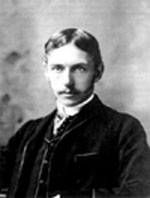Henry Fairfield Osborn
Henry Fairfield Osborn | |
|---|---|
 Paleontologist Osborn, in 1890 | |
| Born | August 8, 1857 |
| Died | November 6, 1935 |
| Nationality | American |
| Alma mater | Princeton University |
| Scientific career | |
| Fields | geology paleontology Eugenics |
Henry Fairfield Osborn (August 8, 1857–November 6, 1935) was an American geologist, paleontologist, and eugenicist, "a first-rate science administrator and a third-rate scientist."[1]
Osborn was born in Fairfield, Connecticut, and studied at Princeton University. He was professor of comparative anatomy from 1883 to 1890 at Princeton. In 1891 he was hired jointly by Columbia University and the American Museum of Natural History, New York. He became professor of biology at Columbia University, becoming professor of zoology in 1896. At the museum he succeeded Morris K. Jesup as president in 1908, serving until 1933, during which time he accumulated one of the finest fossil collections in the world. He assembled a great team of fossil hunters and preparators, which included Roy Chapman Andrews, a gentleman allegedly a possible inspiration for the creation of the fictional archeologist Indiana Jones, and Charles R. Knight, who made murals of dinosaurs in their habitats and sculptures of the living creatures.
He was mentored by the paleontologist Edward Drinker Cope, whom he met on a fossil-hunting expedition in Wyoming . The articulate Fairfield Osborn joined the US Geological Survey in 1900 and became senior vertebrate paleontologist in 1924. He led many fossil-hunting expeditions into the American Southwest, starting with his first to Colorado and Wyoming in 1877, when he met Cope. He described and named Ornitholestes in 1903, Tyrannosaurus rex in 1905, the Pentaceratops in 1923, and the Velociraptor in 1924.
Some of his contributions are less celebrated: Osborn's belief in the now-discredited idea of orthogenesis is one such contribution, his promotion of eugenics, another. Andrews' explorations in the Gobi Desert were in part set in action by Osborn's certainty that the origins of man were to be found in Asia. His unfortunate Man Rises to Parnassus, built on the misleading, but "almost miraculous" Piltdown Man hoax, reveals the deeply-imbedded racism of even the educated classes of his generation, supported on pseudoscience. His (not entirely accurate) description of Hyracotherium as "the size of a small Fox Terrier", has been uncritically copied into many elementary palaeontology textbooks.
His best known publication might be his two-volume work of 1936, The Proboscidea: A Monograph of the Discovery, Evolution, Migration and Extinction of the Mastodonts and Elephants of the World, in which he discussed the fossil history and evolution of elephants and their relatives. A second volume appeared in 1942, after his death. He published many papers on fossil proboscideans during his career.
Osborn wrote an influential textbook, The Age of Mammals in Asia, Europe and North America (1910). He also authored The Origin and Evolution of Life (1916).
He co-founded the Save-the-Redwoods League in 1918. He was long-time president of the New York Zoological Society.
He is also known for his theories on intelligence and racial differences, particularly his work The Evolution of Human Races
He was the father of the conservationist and naturalist Henry Fairfield Osborn, Jr, whom he raised at Castle Rock, the Osborn family estate in Garrison, New York.
Notes
- ^ Reviewer in The American Historical Review 108.2 (April 2003) of the critical modern assessment of Osborn's racialist science, Brian Regal, Henry Fairfield Osborn: Race and the Search for the Origins of Man (Burlington, Vt.: Ashgate) 2002. Osborn as an administrator is discussed by Ronald Rainger, An Agenda for Antiquity: Henry Fairfield Osborn and Vertebrate Paleontology at the American Museum of Natural History, 1890–1935 (1991).
References
- Rainger, R (1980), "The Henry Fairfield Osborn Papers at the American Museum of Natural History.", The Mendel newsletter; archival resources for the history of genetics & allied sciences, no. 18 (published 1980 Jun), pp. 8–13, PMID:11615816
{{citation}}: Check date values in:|publication-date=(help) - Angell (1942), "Unveiling of the Bust of Henry Fairfield Osborn at the American Museum of Natural History.", Science, vol. 95, no. 2471 (published 1942 May 8), pp. 471–472, doi:10.1126/science.95.2471.471, PMID:17789121
{{citation}}: Check date values in:|publication-date=(help) - Gregory (1942), "Unveiling of the Bust of Henry Fairfield Osborn at the American Museum of Natural History.", Science, vol. 95, no. 2471 (published 1942 May 8), pp. 470–471, doi:10.1126/science.95.2471.470, PMID:17789120
{{citation}}: Check date values in:|publication-date=(help)
